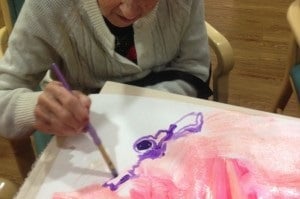Today’s Guest Blogger is Jacinda Bragg from the LCB’s The Lighthouse at Lincoln community.
She sits silently at the table and watches me without expression as I lay out the contents of my plastic bin across from her. I unroll the large cotton canvas onto the table, place paintbrushes at each seating and open the tempura paints. I don’t say a word. I pick up each paint bottle one at a time and hold it up for a better view. I appear as if I’m trying to decide which color to use first, but that isn’t the case. I’m watching her, waiting for a brief change in her facial expression that signals I am holding the most perfect color to paint with. That color is pink.
I open the paint and begin pouring it onto the canvas, making large dramatic circles with each color. Joyce’s eyes follow my every movement but her face remains expressionless. I put the paintbrush in Joyce’s hand. I pick up my paintbrush and drag it through the paint, hoping that she will follow my lead. She slowly starts moving the paint around with her brush. After a moment she puts the brush down and uses her hands to paint the canvas. Suddenly, something remarkable happens, Joyce begins to speak.
Joyce starts telling the other residents, “It’s not messy” and asks them if they are “enjoying it.” Joyce’s daughter and granddaughter are visiting with her and appear shocked. Her daughter explains to me that, due to Alzheimer’s disease, Joyce hardly speaks anymore and when she does it often doesn’t make sense. She also tells me that Joyce used to be a grade school teacher. I realized that in that moment, while painting with her hands, Joyce was taken back to a time that felt very familiar and safe to her.
Communication is a basic human need. It’s how we express emotions, feelings, thoughts, ideas and it’s how we connect to another person. However, for many people with Alzheimer’s and other related dementia, communication can be challenging. As the disease progresses the parts of the brain that control language, reasoning and thoughts become damaged. This can make speaking and understanding speech incredibly difficult for our memory care residents.
Art therapy, simply put, stimulates the brain. It can trigger memories, improve communication and produce a positive social experience. As caregivers, we must realize that self-expression doesn’t always need to be communicated verbally. It is important we provide an alternative means by which our residents can express themselves. Art therapy offers a way for Dementia and Alzheimer’s residents to express themselves when words fail them.
“I found I could say things with color and shapes that
I couldn’t say any other way–things I had no words for.” –Georgia O’Keeffe

